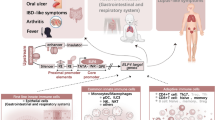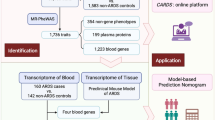Abstract
Mice lacking the transcriptional repressor oncoprotein Gfi1 are unexpectedly neutropenic1,2. We therefore screened GFI1 as a candidate for association with neutropenia in affected individuals without mutations in ELA2 (encoding neutrophil elastase), the most common cause of severe congenital neutropenia (SCN; ref. 3). We found dominant negative zinc finger mutations that disable transcriptional repressor activity. The phenotype also includes immunodeficient lymphocytes and production of a circulating population of myeloid cells that appear immature. We show by chromatin immunoprecipitation, gel shift, reporter assays and elevated expression of ELA2 in vivo in neutropenic individuals that GFI1 represses ELA2, linking these two genes in a common pathway involved in myeloid differentiation.



Similar content being viewed by others
References
Karsunky, H. et al. Inflammatory reactions and severe neutropenia in mice lacking the transcriptional repressor Gfi1. Nat. Genet. 30, 295–300 (2002).
Hock, H. et al. Intrinsic requirement for zinc finger transcription factor Gfi-1 in neutrophil differentiation. Immunity 18, 109–120 (2003).
Dale, D.C. et al. Mutations in the gene encoding neutrophil elastase in congenital and cyclic neutropenia. Blood 96, 2317–2322 (2000).
Horwitz, M., Benson, K.F., Person, R.E., Aprikyan, A.G. & Dale, D.C. Mutations in ELA2, encoding neutrophil elastase, define a 21-day biological clock in cyclic haematopoiesis. Nat. Gen. 23, 433–436 (1999).
Devriendt, K. et al. Constitutively activating mutation in WASP causes X-linked severe congenital neutropenia. Nat. Genet. 27, 313–317 (2001).
Gilks, C.B., Bear, S.E., Grimes, H.L. & Tsichlis, P.N. Progression of interleukin-2 (IL-2)-dependent rat T cell lymphoma lines to IL-2-independent growth following activation of a gene (Gfi-1) encoding a novel zinc finger protein. Mol. Cell. Biol. 13, 1759–1768 (1993).
Papadaki, H.A. et al. Two patients with nonimmune chronic idiopathic neutropenia of adults developing acute myeloid leukemia with aberrant phenotype and complex karyotype but no mutations in granulocyte colony-stimulating factor receptor. Ann. Hematol. 81, 50–54 (2002).
Wallis, D. et al. The zinc finger transcription factor Gfi1, implicated in lymphomagenesis, is required for inner ear hair cell differentiation and survival. Development 130, 221–232 (2003).
Gorlin, R.J. et al. WHIM syndrome, an autosomal dominant disorder: clinical, hematological, and molecular studies. Am. J. Med. Genet. 91, 368–376 (2000).
Grimes, H.L., Chan, T.O., Zweidler-McKay, P.A., Tong, B. & Tsichlis, P.N. The Gfi-1 proto-oncoprotein contains a novel transcriptional repressor domain, SNAG, and inhibits G1 arrest induced by interleukin-2 withdrawal. Mol. Cell. Biol. 16, 6263–6272 (1996).
Zweidler-Mckay, P.A., Grimes, H.L., Flubacher, M.M. & Tsichlis, P.N. Gfi-1 encodes a nuclear zinc finger protein that binds DNA and functions as a transcriptional repressor. Mol. Cell. Biol. 16, 4024–4034 (1996).
Nichols, K.E. et al. Familial dyserythropoietic anaemia and thrombocytopenia due to an inherited mutation in GATA1. Nat. Genet. 24, 266–270 (2000).
Horwitz, M. et al. Role of neutrophil elastase in bone marrow failure syndromes: molecular genetic revival of the chalone hypothesis. Curr. Opin. Hematol. 10, 49–54 (2003).
Duan, Z. & Horwitz, M. Targets of the transcriptional repressor oncoprotein Gfi-1. Proc. Natl. Acad. Sci. USA 100, 5932–5937 (2003).
Li, F.Q. & Horwitz, M. Characterization of mutant neutrophil elastase in severe congenital neutropenia. J. Biol. Chem. 276, 14230–14241 (2001).
Dell'Angelica, E.C., Shotelersuk, V., Aguilar, R.C., Gahl, W.A. & Bonifacino, J.S. Altered trafficking of lysosomal proteins in Hermansky–Pudlak syndrome due to mutations in the β3A subunit of the AP-3 adaptor. Mol. Cell. 3, 11–21 (1999).
Anikster, Y. et al. Mutation of a new gene causes a unique form of Hermansky–Pudlak syndrome in a genetic isolate of central Puerto Rico. Nat. Genet. 28, 376–380 (2001).
Papayannopoulou, T., Priestley, G.V., Nakamoto, B., Zafiropoulos, V. & Scott, L.M. Molecular pathways in bone marrow homing: dominant role of α4β1 over β2-integrins and selectins. Blood 98, 2403–2411 (2001).
Duan, Z., Stamatoyannopoulos, G. & Li, Q. Role of NF-Y in in vivo regulation of the γ-globin gene. Mol. Cell. Biol. 21, 3083–3095 (2001).
Acknowledgements
We thank P. Tsichlis for reagents and advice, J. Miller for advice, K. Williams for technical assistance and the subjects for their cooperation. M.H. thanks the late D.M. Horwitz for his encouragement and support. This work was supported by the U.S. National Institutes of Health, Doris Duke Foundation, Leukemia & Lymphoma Society and Burroughs-Wellcome grants (M.H.) and Hope Street Kids grant (H.L.G.).
Author information
Authors and Affiliations
Corresponding author
Ethics declarations
Competing interests
The authors declare no competing financial interests.
Rights and permissions
About this article
Cite this article
Person, R., Li, FQ., Duan, Z. et al. Mutations in proto-oncogene GFI1 cause human neutropenia and target ELA2. Nat Genet 34, 308–312 (2003). https://doi.org/10.1038/ng1170
Received:
Accepted:
Published:
Issue Date:
DOI: https://doi.org/10.1038/ng1170
- Springer Nature America, Inc.
This article is cited by
-
Heterogeneous genetic landscape of congenital neutropenia in Korean patients revealed by whole exome sequencing: genetic, phenotypic and histologic correlations
Scientific Reports (2022)
-
HMG20B stabilizes association of LSD1 with GFI1 on chromatin to confer transcription repression and leukemia cell differentiation block
Oncogene (2022)
-
Identification of GFI1 mutations in adult patients with congenital neutropenia
Annals of Hematology (2022)
-
Subtypes of schizophrenia identified by multi-omic measures associated with dysregulated immune function
Molecular Psychiatry (2021)
-
Defects of the Innate Immune System and Related Immune Deficiencies
Clinical Reviews in Allergy & Immunology (2021)





